Outdoor Metal Sculpture High School Art Project for Veterans
Practice Ho Suh discusses his time in the Korean armed forces, and how information technology informed his 2001 sculptural installation Some/One.
Art21: Why practice yous have these war machine supplies in your studio? What'south your interest in them?
Suh: I have some old army surplus stuff that I collected for a school assignment, which ended upwards being the commencement sculpture in my life. I didn't really use these things. I was going to, but I sort of changed my mind. Somehow the project came from collecting these materials and also from my interaction with the ground forces-and-navy-surplus store possessor, who happened to be an old Korean guy in Cranston, Rhode Island.
I explained to him that I was doing a projection at schoolhouse, and he gave me a lot of stuff for free. And he had many domestic dog tags. At the army surplus, they make dog tags for you lot. And sometimes they make a error and spell wrong, and and so they take these rejects. And also, he helped me to get the blank canis familiaris tags and gave me a actually good deal. Not only that, he allowed me to use this special typewriter for the dog tags. And information technology was spring suspension, so I went there every day, I think, for almost 2 weeks and typed domestic dog tags. And I had around thirty thousand dog tags there. And nosotros had a conversation, you know; we talked about things going on, back in Korea.
But it all started with an assignment for this sculpture class that I accidentally took. I was a painting major at RISD (Rhode Island School of Pattern), and at RISD, you accept to have at least one non-major constituent studio course. And I wanted to take a glassblowing class, but it was already filled. So, this sculpture course was the simply course that was open. And information technology was called "The Effigy In Gimmicky Art." It changed my life because it was simply such an important experience, and subsequently that class, I slowly abandoned my painting and then became a sculptor. The consignment was using the form of wearable to address this consequence of identity. And that was just one semester after I came hither from Korea. That was also right afterwards the L.A. riots, and I call up there were some issues related to the Korean-American communities in 50.A. during the riots. That was what really immune me to think well-nigh my identity as a Korean in the The states, through that project. I remember somehow my experience in the military in Korea was also something that I wanted to accost through the project. So, that's why I got into the whole military stuff.
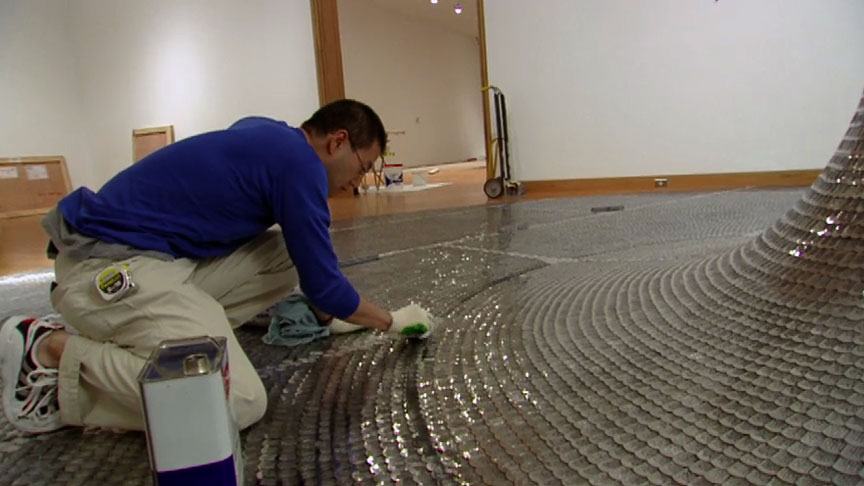
Practice Ho Suh installs Some/One (2001) at the Seattle Art Museum, Washington, 2002. Production notwithstanding from the Art in the 20-First Century Flavor 2 episode, Stories, 2003. © Art21, Inc. 2003.
Art21: Unlike the United States, in Korea, young males are required to do military service. What was that similar for you lot?
Suh: Yes, every male person has to go. It's mandatory. I was in the army for almost two years. It'southward probably a unlike experience than here, considering from the moment that you're built-in, you know that you're going to exist in the military. Everybody has to become. And then, that's a bully bargain of the Korean man's identity. And normally everyone goes to the military correct after they graduate from high school. It'due south a expert initiation to the real world considering the whole Korean society, the whole system, is actually based on this militaristic, very hierarchical construction. And so, you lot larn a lot of things from the military earlier you have a real job.
I was a little chip of a different instance. I was probably one of the oldest soldiers in the entire division because I went to graduate schoolhouse and then went to war machine. Then, I was, like, six or vii years older than most of the soldiers. I was the same age equally a captain, so it was quite an experience. I mean, physically information technology was very difficult. But at the same time I was just quondam enough to accept everything too seriously, I judge.
I was really good at many things. I was a sharpshooter. And I had a black belt before the military, and then that was like shooting fish in a barrel. And I could run really fast and that was very helpful. Simply considering of my age, I think it took me longer to recuperate from the hard training. And the way they treat you . . . Basically, they railroad train you every bit some kind of—you lot know, I don't know if this is something that I should say or not—but after several weeks of boot camp, in that location were, similar, two days of holiday. And I felt that I cannot be killed—similar, anything—so, like, if a car hits yous . . . I felt similar I could survive that. That's actually a skilful manner of putting it. The whole program was basically pushing your psychological and physical limits to extremes, and then actually you can kill someone.
And, you know, that whole experience was very hard to swallow. Information technology's a process of dehumanization. And you got a lot of punishment. At present it sounds really hilarious, but during that time, information technology was like, "This is crazy!" I accept some great stories, just I think they're irrelevant. Similar, the younger kids didn't really care, you know. And for me, everything was something to think about. Then, I recollect that was the difference, of being a little bit older than other guys.
I wanted to come to the U.S. fifty-fifty before I joined the army. But I retrieve, in the army, I experienced what it means to be dehumanized. So, that was tough. I was challenged in many unlike ways, physically, but too information technology wasn't like the regular army that I always imagined. Information technology was a very difficult time, just at the same time, I'thou glad that I did it. Every man talks about it, their own experience in the military machine. You know, like, when you lot have a drink with someone, and it's only unbelievable. They're unbelievable stories. And also they were funny times. Great times, too, unreal mostly.
Art21: Why does this American military equipment bring up these memories for yous?
Suh: Basically we used almost the same equipments as Americans. The whole thing is based on the U.Southward. military system. I retrieve also that, probably, almost Korean men besides accept this interest—I don't know if information technology'south the right word—just some kind of fetishism about this stuff. In Korea, it'due south illegal to buy or take armed forces stuff. And so, when I saw these things, I wanted to get it. But afterwards that piece was done, I never actually opened this box. It was sealed until now. And I just really didn't need to await at it.
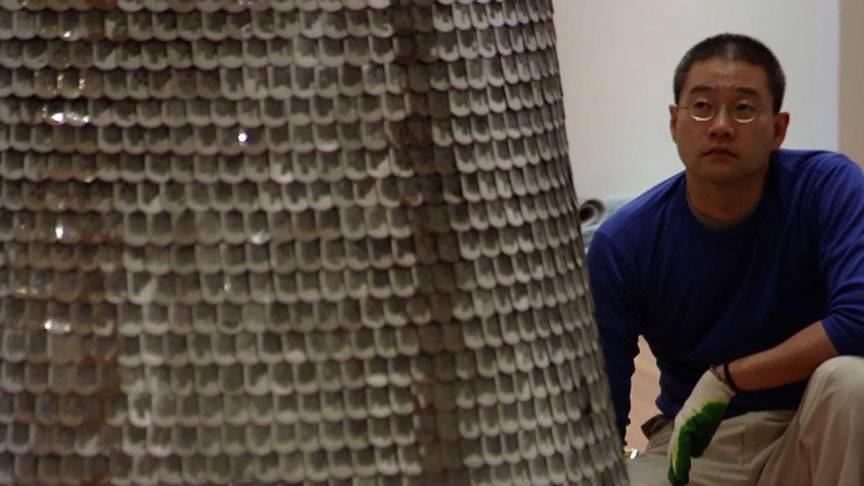
Do Ho Suh installs Some/One (2001) at the Seattle Fine art Museum, Washington, 2002. Production still from the Art in the Xx-First Century Season ii episode, Stories, 2003. © Art21, Inc. 2003.
Art21: What did your kickoff sculpture, Metal Jacket, look like—the ane y'all made for your sculpture grade?
Suh: It looks like a kind of ancient Oriental armor. The first sculpture was covered with three yard military dog tags. From a distance, the dog tags look similar fish scales. The shape of that jacket was not something that I invented. I used the U.Due south. military jacket liner and just put the dog tags on top of it. And so, I used all gimmicky materials, simply they concluded up looking similar ancient ones.
Art21: Perhaps this is a lightheaded question, just do you think your experience in the military influenced your conclusion to become a sculptor?
Suh: I didn't even want to exist a sculptor at all, that's one thing for certain. And I didn't want to make something about the war machine at all, either. Merely gradually, information technology came very naturally. For me, once more, this feel in the military was non something special, because anybody had to get through and has to become through that procedure in Korea. So, if you talk to someone who went to war machine, they all have similar stories. That made me a fiddling scrap more comfortable to use this military machine experience. Perchance it'south something special here in the States. But if I bear witness Some/One in Korea, then I call up it will go a unlike response considering information technology was part of their everyday life.
Art21: Where did the dog tags come from, and what do they mean to you lot?
Suh: I became interested in the thought backside the military canis familiaris tag. It'south a form of identification, and information technology's made out of stainless steel. Then, it'due south a permanent material; it will not rust. And each soldier has to carry two domestic dog tags. And when a soldier is killed in battle, one canis familiaris tag has to remain on the dead body, and ane is taken away by a surviving soldier in society to report the death of that soldier, in order to secure the identity of that soldier. (I don't think information technology'southward actually a practical matter to exercise, only yous put these dog tags in your oral fissure—and so, basically, between your upper and lower teeth—and you simply kick your jaw, and then that will go betwixt your teeth. This is what I was told to practise in Korea and in the armed forces.)
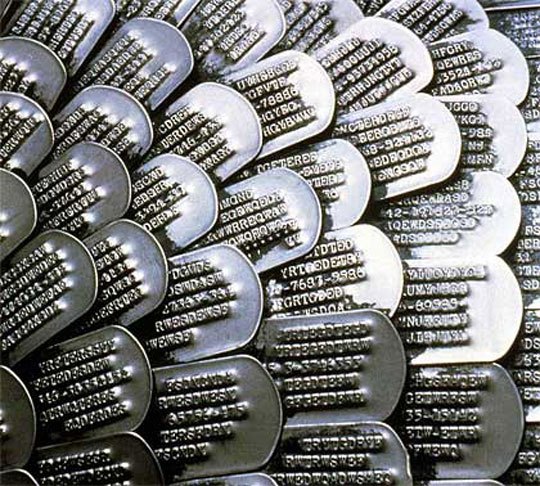
Do Ho Suh. Some/One, item, 2001. Installation view at Korean Pavilion, Biennale di Venezia, Venice, Italy. Courtesy of the artist and Lehmann Maupin Gallery, New York.
Art21: What was the title of that first sculpture?
Suh: The championship of that work is Metal Jacket. I was almost going to use Full Metallic Jacket, but I call back that was likewise much.
Art21: Are the dog tags typed in English or in Korean?
Suh: Oh, it'south in English. Yep, English and numbers. It's totally nonsense, only a series of letters and numbers.
Art21: Can yous talk a trivial nigh Some/One?
Suh: Well, Some/One evolved from that starting time sculpture, Metal Jacket. The old work never goes away. Information technology stays in that location; you merely don't notice information technology. But I think, in the dorsum of my mind, I constantly thought nearly it. I had a dream one twenty-four hour period, after I finished Metal Jacket, when I knew that I wanted to plough this piece into some kind of larger installation, just I didn't take the money, space, or the chance to do it. But I recall, at a subconscious level, I had been thinking nigh information technology for a long time.
And the dream was quite vivid. It was night, and I was outside of this kind of football game stadium, and I was approaching this stadium from the distance. And I saw this low-cal in the stadium, and then I thought in that location's some kind of activity going on. And as I approached the stadium in order to enter the stadium, I started to hear these clicking sounds, like the sound when the metal pieces bear on together. It was like there were thousands of crickets in the stadium. And and then I entered the stadium in the manner that the football players enter the stadium. I walked slowly and went into the stadium on the ground level, and then I meet this reflecting surface in the dream. And I realized I was stepping on these metal pieces that were the military domestic dog tags. And it was slightly vibrating; the dog tags were touching each other, and the audio was from that. And from distant, I saw the central effigy in the centre of the stadium. I slowly proceeded to the center, so I realized information technology was all i piece that gradually rose up and formed this one figure. And information technology tried to become out the stadium but couldn't go out considering the train was merely besides big—you know, it was just too big to pull all the canis familiaris tags.
And so, that was the dream and the image that I got. After that, I made a small cartoon. The small drawing was about this vast field of military dog tags on the basis and so a small-scale figure in the center. That was the prototype I got, and I simply waited. I waited for the right fourth dimension to come. I mean, obviously, I could not create the piece that I dreamed of; it'southward impossible. Just information technology was a kind of image and a kind of hope. That was the impact that I wanted to somehow convey through that slice.
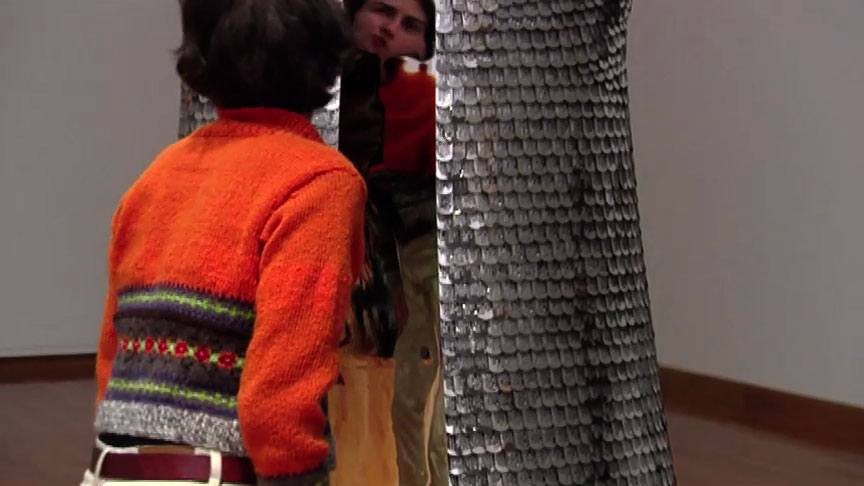
Practise Ho Suh. Some/1, item, 2001. Installation view at the Seattle Art Museum, Washington, 2002. Courtesy of the artist and Lehmann Maupin Gallery, New York. Product notwithstanding from the Art in the Xx-First Century Season ii episode, Stories, 2003. © Art21, Inc. 2003.
Art21: When the viewer approaches the slice, it's a like experience to your dream because the figure of Some/One is hollow, and inside are all these mirrors. Information technology comes as quite a surprise.
Suh: Every time I install Some/One, y'all e'er face up the dorsum of the piece, first. That's how I orient my piece. And that ways y'all don't come across the interior of the piece when you enter the room. You have to go through the steps, and walk on the piece, and then walk effectually the piece. And so, finally, yous face up the front end of the piece, and then you are able to encounter the inside of the slice. And that moment is very of import, I think—not only experiencing the piece physically, by stepping on the domestic dog tags, but also when you lot see the reflection of yourself inside of the piece. Then, you truly become a function of the slice.
I wanted the viewer to take an experience with these little canis familiaris tags, these thousands of domestic dog tags. Information technology symbolizes each individual's identity: these many dog tags create this ane, larger-than-life effigy. It'south ambiguous whether you're a part of it or non, whether you lot are the owner of this robe when you see your ain epitome over there. And so, that's why I had the mirror inside. And also, it's an platonic situation because it gives the inside a particular lighting. It's difficult to create that kind of situation, merely because of the illusion and the reflection, you lot experience similar there is some other dimension inside. Information technology'due south just really hard to see the depth and where the surface stops. Information technology's really hard to see that, and it becomes like some other dimension.
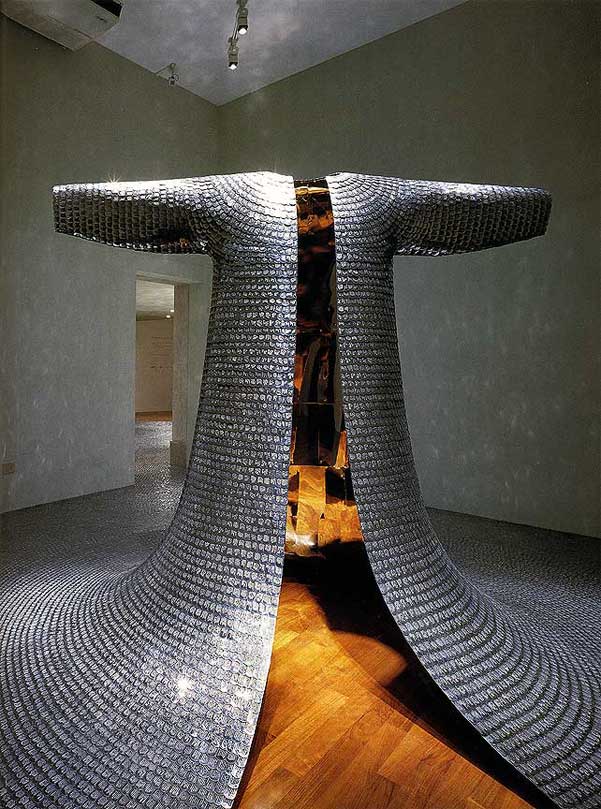
Do Ho Suh. Some/Ane, detail, 2001. Installation view at Korean Pavilion, Biennale di Venezia, Venice, Italia. Courtesy of the artist and Lehmann Maupin Gallery, New York.
Art21: Exercise yous intend for the work to exist read in a particular way?
Suh: I knew that if I extended the train or tail of the Metal Jacket piece, that information technology would look like an emperor's robe. And so, I went with that. But information technology could be read equally then many different things. Somebody told me it reminded [him] of Christ or that statue in Rio de Janeiro. And a lot of Koreans call back that information technology looks like the armor of this very famous general in the fifteenth century, who protected Korea from Japanese invasion; and we have a statue of him in the eye of Seoul. Likewise, this full general invented a battleship that looks like a turtle. And the turtle has this exoskeleton that looks like fish scales. And the way they arranged the metallic on the send was exactly the aforementioned way I did it in the Some/One piece. And then, not only Full general Lee but likewise his transport and everything else somehow all come together in this one slice. I allow people to brand multiple associations to the piece of work; I really like it, when that happens. I don't know whether it's simply coincidence or not, but I recall I carefully managed to keep the piece of work open up, so information technology could be read in different means.
This interview was originally published on PBS.org in September 2003 and was republished on Art21.org in November 2011.
Source: https://art21.org/read/do-ho-suh-some-one-and-the-korean-military/
0 Response to "Outdoor Metal Sculpture High School Art Project for Veterans"
Post a Comment